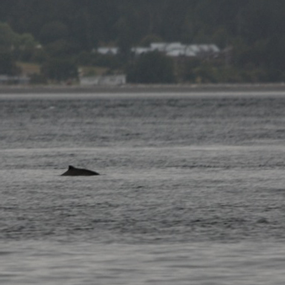This past week (June 28 & 29, 2011) SeaDoc co-hosted a Rockfish Recovery Workshop in Seattle with the State Department of Wildlife and NOAA Fisheries.
Nearly 100 scientists, fisheries managers, fishers and SCUBA divers attended the 2-day workshop to discuss the current state of knowledge on rockfish and to identify future needs related to recovering depleted rockfish populations in the Salish Sea.
 There are 28 species of rockfish in the Salish Sea. Thirteen (13) are listed as species of concern and recently 3 species were listed under the US Endangered Species Act.
There are 28 species of rockfish in the Salish Sea. Thirteen (13) are listed as species of concern and recently 3 species were listed under the US Endangered Species Act.
In addition to helping organize the workshop, SeaDoc also helped bring in Canadians to share their perspective on what has and has not worked with rockfish recovery on the other side of the border.
A lot of the research SeaDoc funded over the last 10 years was presented and plans were laid for moving rockfish recovery forward. The meeting proceedings will be published soon and will be available here on the SeaDoc website.
In the meantime, here's a recap:
(Please note that this summary is taken from my notes and if there are errors or misstatements they are mine, not the researchers/presenters! -Joe T.)
Historical Context Session
Wayne Palsson spoke on the biology and assessment of rockfishes in Puget Sound. Rockfishes are a diverse group of species with different life histories. They require various habitat during different life stages. They are adapted for slow growth, long survival, late maturity, low natural mortality rates, and high habitat fidelity. These are all factors that make recovery tough. There's a lack of long-term data that makes it hard to create conventional age-structure population models and biomass dynamic models.
Chris Harvey reviewed the ecological history of rockfish exploitation in Puget Sound. Rockfish bones have been found in middens dating back 1,500 years. Much of the fishing pressure on rockfish began after the Boldt decision in 1974, which required that harvests in Puget Sound be coequally managed by the State government and the Treaty Tribes of Washington. It's also been influenced by demographic trends and by the promotion of the fishery by State government. (Unfortunately, as covered in Wayne Palsson's talk, it wasn't until 1982 that scientists learned that rockfish were generally 2 to 3 times longer lived than they'd thought, which meant the existing population models were not accurate.) By the time management efforts were deemed necessary, the greatest harvests had already occurred.
Anne Beaudreau discussed her work to reconstruct historical trends in rockfish abundance. The lack of data on historical populations of rockfish is a major barrier to developing sustainable fisheries. Beaudreau and colleagues interviewed 101 individuals ranging in age from 24 to 90 years to try to derive trends in the abundance of rockfish from 1940 to the present. Of particular interest was the evidence of "shifting baselines." To a statistically significant degree, each age group of respondents interpreted the conditions at the beginning of their awareness as "abundant" and saw declines from there, but what was "declining" to an older person was "abundant" to a younger person.
Benthic Habitat Surveys/Rockfish Abundance Estimates Session
Gary Greene presented the Salish Sea sea floor mapping project, which has produced bathymetric and habitat maps of the San Juan Islands area. Rockfish prefer particular habitat types, and the multibeam echosounders used by Greene and his colleagues allows these potential habitat areas to be identified. (Other participants were very interested in having these maps for other areas in the Salish Sea.
Bob Pacunski spoke on work to use non-lethal methods to survey rockfish populations. Traditional trawl or long-line sampling results in fish mortality, but using a small remotely-operated vehicle has been shown to be effective at providing population surveys.
Stressors Session
Joan Drinkwin of the Northwest Straits Foundation spoke on the threat posed to rockfish by derelict fishing gear, including both nets and traps. The Northwest Straits Initiative has removed 3,860 nets from Puget Sound, all at less than 105 feet deep. There are 950 shallow-water nets still in the water, and at least 70 in deeper water. Based on studies of net mortality by the SeaDoc Society, approximately 1,600 rockfish per year are captured and killed in derelict nets each year in the United States portion of the Salish Sea.
...More coming soon...
 Although the harbor porpoise is the most abundant and widely dispersed cetacean species in the Salish Sea, we still know very little about its habitat needs, distribution, population trends, life cycle, genetics, behavior and role in the ecosystem.
Harbor porpoises feed primarily on fish and are among the smallest of the cetaceans, reaching an average size of about 5 feet and 120 pounds. They can dive deep, more than 655 feet, but usually stay near the surface, coming up regularly to breathe with a distinctive puffing noise that resembles a sneeze.
Although the harbor porpoise is the most abundant and widely dispersed cetacean species in the Salish Sea, we still know very little about its habitat needs, distribution, population trends, life cycle, genetics, behavior and role in the ecosystem.
Harbor porpoises feed primarily on fish and are among the smallest of the cetaceans, reaching an average size of about 5 feet and 120 pounds. They can dive deep, more than 655 feet, but usually stay near the surface, coming up regularly to breathe with a distinctive puffing noise that resembles a sneeze.


 There are 28 species of rockfish in the Salish Sea. Thirteen (13) are listed as species of concern and recently 3 species were listed under the US Endangered Species Act.
There are 28 species of rockfish in the Salish Sea. Thirteen (13) are listed as species of concern and recently 3 species were listed under the US Endangered Species Act.